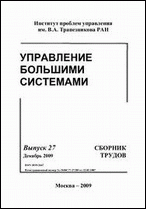|
This article is cited in 2 scientific papers (total in 2 papers)
Systems Analysis
Basic combat models
V. O. Korepanova, A. G. Chkhartishvilia, V. V. Shumovb
a V.A. Trapeznikov Institute of Control Sciences of RAS, Moscow
b International Research Institute for Advanced Systems, Moscow
Abstract:
The paper presents three approaches to the description of combat operations and the modeling results: game-theoretic models of the optimal distribution of forces and means of the parties in directions and echelons (tasks) in tactical models of oncoming combat offensive and defense; expansion of the Osipov-Lanchester models of the dynamics of combat operations; simulation models of combat units. As an indicator of the effectiveness of combat operations, it is proposed to use the probability function of the victory of one of the parties, depending on their numbers and the combat superiority of one of the parties. Game-theoretic models of "offensive-defense" (oncoming combat) are solved in two stages. At the first stage, according to one of the three criteria (breakthrough of the weakest point, breakthrough of at least one point, weighted average probability of a breakthrough taking into account the value of the points), the optimal distribution of the forces and means of the parties by points (along the front) and the value of the game are found. At the second stage, according to two criteria, the optimal distribution of forces and means between tactical tasks (echelons) is found under the assumption that when solving the immediate task, the parties are guided by the criterion of breaking through the weakest point of defense. The formulation of the masking problem using the approach of reflexive games is also given. The last section proposes a discrete-time algorithm for simulating units combat. It is proposed to take into account the characteristics of the battlefield, the dynamics of the position of combat units of the parties, the types of units (which determine the average speed of units, the range of detection and effective defeat), UAVs, the angle of fire, the effect of camouflage. To test the proposed algorithm, a simulation model of an oncoming battle was built, with the help of which the dependencies of the victory of one side on the decisiveness parameter were obtained. The perspectives of the approaches are discussed.
Keywords:
combat operations, offensive-defense models, distribution of forces and resources, game theory, dynamics of combat operations, simulation model, victory function, units combat, camouflage, reflexive games.
Received: September 8, 2022
Published: May 31, 2023
Citation:
V. O. Korepanov, A. G. Chkhartishvili, V. V. Shumov, “Basic combat models”, UBS, 103 (2023), 40–77
Linking options:
https://www.mathnet.ru/eng/ubs1150 https://www.mathnet.ru/eng/ubs/v103/p40
|

| Statistics & downloads: |
| Abstract page: | 146 | | Full-text PDF : | 327 | | References: | 27 |
|




 Contact us:
Contact us: Terms of Use
Terms of Use
 Registration to the website
Registration to the website Logotypes
Logotypes








 Citation in format
Citation in format 
